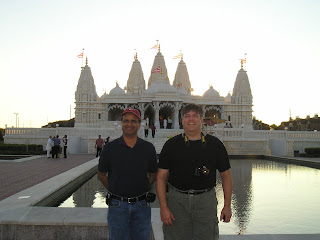
I had the pleasure of working with a couple of gents on my last engagement in Houston who kept me laughing even through the rough patches. That’s one of the best ways to deliver success in my opinion. One of the other positives that I got from this particular trip was a little Indian cultural education.
Our technical genius, Sahadev, suggested Pete and I accompany him to a temple he had found. No religious agenda, no ritual requirement type things. He just knew of our interest in learning, world religions and architecture. It was hands down the coolest thing I saw while in Houston.
From their visitor pamphlet:
Welcome to the first traditional Hindu Mandir of its kind in North America. Experience hours of discovery and enjoyment at the BAPS Shri Swaminarayan Mandir. The Mandir is a masterpiece of intricate design and workmanship, replete with its 5 towering white pinnacles, 12 smooth domes and glittering 136 marble pillars. Over 33,000 pieces of Italian marble and Turkish limestone were hand-carved by skilled craftsmen and assembled by volunteers in just 16 months. Ancient Indian arts, traditions and philosophy have been encompassed in this house of devotion and worship that is a testimony to human commitment. The Mandir opened to all after the Murti-Pratishtha ceremony was performed by his Divine Holiness Pramukh Swami Maharaj on July 25, 2004.
Wow, that’s a lot to digest. So let’s break it down this way. Top 10 things I learned from Sahadev and company that trip, in no particular order:
1) There is symbolism to the architectural domes and peaks – They represent the mountains as the saints meditate in mountainous regions and temples are supposed to provide such environments on entry.
2) I’m not a huge fan of authentic Indian candies – at least the one I had that night (sorry SK).
3) There were several animal/human forms depicted throughout the temple. The elephant God, who helps in preventing obstacles, is Lord Ganesha who is the son of Lord Shiva and his consort Goddess Parvati. Those figures with musical attachment represent the importance of music associated with the religion. Some of the Gods and Goddesses sported their own musical instruments. Goddess Saraswati plays Veena, a string instrument, and Lord Krishna plays flute…
4) Indian music is much more tonal than rhythmic – in some cases. And Sahadev’s brother is one heck of a vocalist (Sahadev wouldn’t let me hear him sing himself, but from what I hear, he’s not too shabby either.)
5) There was a side chamber where men and women entered separately below the structure. We removed our shoes and walked into a type of shrine. There was a small figure in a fountain representing the young Swami Narayan (known as Neelkanth Varni) who is the founder of the Swami Narayan Sect. We each took a vessel, poured water over the head of the figure – a symbolic prayer/offering for spiritual upliftment and fulfilment of wishes. So far, mine is still being answered – it’s an ongoing hope.
6) You must wear pants! (Pete, I’m looking at you). But they will provide a wrap if needed. Just don’t try to leave with it. (I’m still looking at you Pete).
7) Only take pictures from behind the reflecting pool. Much like any other religious facility, there is a decorum that accompanies any sacred place. Play nice people.
8) Each Swami is the sect leader starting from the first one to the current leader and hence their religious status.
9) Hindu temple tour guides are some of the coolest people ever. I think this guy we had spent maybe an hour with us. No hand out for a tip, no hustle you through, just a volunteer who wanted to educate. That’s a pretty cool community where people gives of themselves just to pass on what they have learned to those who ask to know.
10) Rules surrounding what Sahadev prefers to eat are so both binding and liberating. Many places, he was limited to an appetizer and a dessert. Insanity… or Genius?! I’ll let you decide.
Want to check it out yourself? Here is the Houston Mandir’s Site.
Or if you are in India, Sahadev suggests you check out the largest temple in New Delhi, India.
Thanks for the experience (and help with this post) Sahadev!


No comments:
Post a Comment